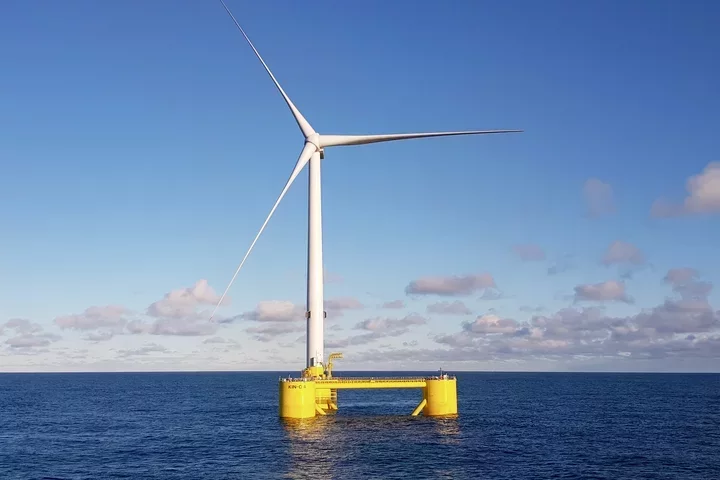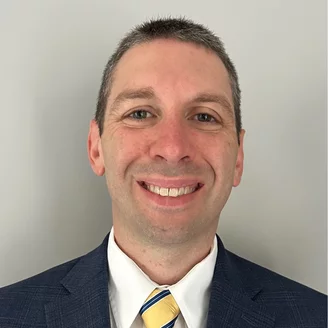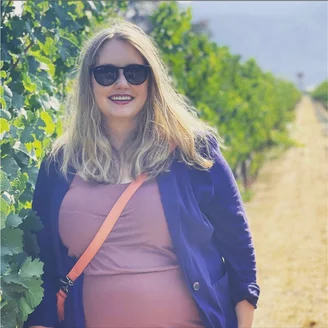A 9.5-megawatt floating wind turbine deployed at the Kincardine Offshore Wind project, located off the coast of Aberdeen, Scotland. Photo: Principle Power
###
A few months back, the Outpost sat down with a couple of folks from Vineyard Offshore, a North America-based developer for Copenhagen Infrastructure Partners, to talk about offshore wind development on the North Coast. Now, we’d like to introduce you to the second developer, RWE.
Last December, RWE Offshore Wind Holdings, LLC, a German multinational energy company, and California North Floating, LLC, a subsidiary of Copenhagen Infrastructure Partners, placed the winning bids for two lease areas in the Humboldt Wind Energy Area, located roughly 20 miles west of Eureka.
In our interview – conducted via email – Rob Mastria, Humboldt Offshore Wind project director for RWE, and Ciara Emery, RWE’s local government and stakeholder engagement manager, address some of the concerns surrounding floating offshore wind and talk about the community benefits that will come along with it.
Mastria has worked on the development of renewable energy projects – primarily in onshore and offshore wind – for the last 15 years. Before joining RWE, he served as the development director of the South Fork Wind Project currently under construction on the East Coast. Emery has spent the last decade living and working in Humboldt County, as a student at Humboldt State University (now Cal Poly Humboldt) and as a field representative for Congressman Jared Huffman’s office.
Our conversation has been lightly edited for length and clarity.
###
LoCO: First, can you tell me a bit about RWE and the company’s history in renewable energy and offshore wind?
Rob Mastria: RWE is a top-tier renewables company in the U.S. and a global leader in offshore wind with a focus on decarbonization and sustainability. Our two decades of experience in offshore wind has resulted in 19 offshore wind farms globally. Now, we are bringing our expertise to communities on the East, West and Gulf Coasts to build our clean energy future.
LoCO: RWE placed one of the winning bids for the two leases within the Humboldt Wind Energy Area at the end of last year. Of course, it’s a little early to talk specifics but tell me about your vision for offshore wind on the West Coast.
Mastria: California has a remarkable opportunity to meet its ambitious climate targets (like reaching net zero by 2045), become a global leader in floating offshore wind and reshape regional economies – like Humboldt’s – through the development of these lease areas. The North Coast is unique in its character, communities and history, and this project will be a critical component of the state’s efforts to establish a floating offshore industry. Our vision for California is to unleash the benefits of offshore wind by developing one of the nation’s first large-scale floating wind projects in a safe, efficient and sustainable manner that benefits the community and the state for decades to come.
LoCO: Can you also talk about some of the floating offshore wind projects RWE has developed to date? What were some of the challenges you encountered during the planning process and how were those issues resolved?
Mastria: As I mentioned, California’s floating offshore wind developments will be some of the first large-scale projects. However, decades of experience in offshore wind development, combined with in-house engineering expertise, extensive supply chain engagement and participation in leading joint-industry projects, has positioned RWE at the forefront of innovation in the floating market. RWE also has several high-profile, floating offshore wind demonstrations that are currently operational in Europe. Insights from these demonstrations – coupled with our research and expertise – will inform the best methods, materials and technologies needed to successfully deploy floating offshore wind, while helping to drive down the costs and risks associated with advancing an industry in California.
LoCO: I imagine you’re still getting to know our community, but where is your present focus on offshore wind development in Humboldt?
Ciara Emery: Community members and North Coast residents have been considering offshore wind energy off the coast of Humboldt County for several years now. The Redwood Coast Energy Authority in particular has played a critical role in engaging the local community on our energy future. RWE’s first steps are focused on becoming a good neighbor and building relationships early. Getting projects of this scale online is a long process that requires collaboration every step of the way. Deepening our engagement locally and building a foundation will help ensure the project generates long-term benefits for the community.
LoCO: As I’m sure you can imagine, there are concerns surrounding offshore wind development on the North Coast. Our community wants to know that offshore wind developers are willing to work with the community throughout this process to ensure that the projects are the best projects they can be. They want to be reassured that developers are going to include tribal communities, fishermen, environmental advocacy groups, and local governments every step of the way. Can you speak to that?
Emery: I hear that from the community every day and it’s exactly why we’re committed to building a collaborative development process. Our ambition is to ensure every voice is heard, and RWE is hiring staff locally in Humboldt – starting with myself – that will frequently engage with community groups, businesses, Tribal organizations and governments, educational institutions and local fisheries. To date, our team has met with over 50 individual organizations, Tribal governments and elected officials in the region and we’ll continue to foster an ongoing dialogue through each project phase. We recently had a wonderful discussion with Arcata Sunrise Rotary – even though it was at their regular 7 a.m. meeting, the early hour didn’t prevent members from having a robust conversation about what they might want to see through this development process. Their energy was infectious and really exciting.
LoCO: I know some people are concerned about the newness of floating offshore wind energy technology. Some folks feel there hasn’t been enough research into the potential consequences of the technology. Can you speak to that point as well?
Mastria: Though floating offshore wind is new, particularly in the U.S., there are decades of research and real-world demonstrations that show this technology is a viable, safe and efficient alternative to greenhouse-gas-emitting energy sources. Current projects in Europe and Asia are generating power on a megawatt-scale, and recent expansion of floating offshore wind projects is expected to increase power generation to the gigawatt scale in the next 10-20 years. Our floating offshore wind demonstrations in Europe – including TetraSpar off the coast of Norway and DemoSATH off the coast of Spain – also provide direct experience with this technology and arm us [with] insights that will inform its deployment in the U.S. We’re traveling to these demonstration projects with community members so they have firsthand exposure to floating offshore wind and better understand what it could look like off the North Coast too.
It’s important to remember that all industrial-scale infrastructure technology was new at some point, but that doesn’t mean we should overlook the potential benefits of investing in and growing such vital projects. Recent public investments into the development of this technology in the U.S. prove that both the state and federal governments understand the importance of including floating offshore wind in our nation’s growing renewable energy portfolio.
LoCO: Our local fishing fleet also has concerns about how the offshore wind development will affect their grounds. Over the years, their fishing grounds have gotten smaller and smaller due to increased regulations around commercial fishing. Can you talk about how RWE has worked with commercial fishermen on other projects to alleviate some of these concerns? How will that inform your conversations here?
Emery: RWE is utilizing the experience we’ve gained on the East Coast working closely with local and regional fishermen to inform our approach on the West Coast. Our fisheries team has already engaged in more than 40 interactions with the local Northern California fishing industry and is coordinating closely with the fisheries to avoid, minimize and mitigate any potential impacts related to the Humboldt project.
On the East Coast, we have engaged in proactive outreach to more than 500 fisheries within the New York Bight lease area, in coordination with our local fisheries advisors, to establish an open dialogue with ocean users that might be operating within or transiting through the lease area. We have hired two local fisheries representatives and are working with local onboard fisheries liaisons who will be managing survey vessel communications with the local fishing fleet. Additionally, we conducted a pre-survey risk assessment to avoid areas with high seasonal concentrations of fixed gear.
RWE’s work on the West Coast will mirror this comprehensive approach. We understand that coexistence with fisheries means having a thriving fishing industry in Humboldt and look forward to working collaboratively to achieve successful outcomes for fisheries and offshore wind energy.
LoCO: Another concern that frequently comes up in conversations surrounding wind energy are potential impacts to whales and birds. What has RWE done in the past/plans to do in the future to mitigate these concerns?
Mastria: Our experience in the industry has shown us that offshore wind, fisheries and other ocean users can coexist. Assessing and mitigating potential marine impacts is essential to our work as a responsible community partner, and we take the health and well-being of marine mammals and other protected species very seriously. We will staff each vessel with third-party protected species observers to minimize potential interactions, implement requirements to halt survey and development activities if marine life is found within a certain distance of the survey work, and review and approve survey plans before operations commence to ensure that offshore wind development efforts are environmentally safe.
Given some recent news coverage, I want to also flag that there is no current evidence to link recent unusual marine mortality events off the coast of the U.S. to offshore wind energy development – vessel strikes and fishing gear entanglements are more likely the cause. RWE and the U.S. offshore wind industry at large will continue seeking ways to work with other ocean users while seizing the generational opportunity to revitalize Humboldt’s economy and combat climate change.
LoCO: Can you also talk a bit about Community Benefits Agreements and how RWE will work with the community to develop the agreement? What does that process look like? And can you talk about previous experiences in developing community benefits agreements?
Emery: Community Benefits Agreements will be a cornerstone of RWE’s partnership with the Humboldt community. While many people are excited for this new industry to materialize, we need to remember that we are still at the beginning of the beginning. We are committed to ongoing collaboration with Tribal Nations and local communities to understand the unique needs and the most impactful potential benefits. The project’s long runaway allows for this robust dialogue and will help drive CBAs that are reflective of the region’s priorities.
LoCO: Again, it’s probably too early to talk specifics, but how will RWE work with the other lease area developer – Vineyard Offshore – throughout the planning process? For example, will the two lease areas use the same technology?
Mastria: RWE actively collaborates with other developers to address shared issues, propose solutions and overcome industry-level barriers. We are and will continue to collaborate with the Vineyard Offshore team to better understand the needs of the Humboldt Wind Energy Area. While the specific technology we will be using to develop our respective projects is still being explored, we are committed to working with our regional partners to help ensure these projects are safe, efficient and deliver clean power to California.
LoCO: What’s next for RWE and the Humboldt Wind Energy Area?
Mastria: One of RWE’s biggest priorities has been the establishment of a central procurement framework for offshore wind energy in California. We are elated that appears to be moving in the right direction with recent updates to AB 1373, and we hope for passage of this bill before the end of this legislative session. We are also closely following the transmission planning process that is evaluating new transmission lines in Humboldt County so that we are able to connect our floating wind project to the bulk electric system.
(Note: AB 1373, which would create a process for offshore wind procurement and increase grid reliability across the state, passed the California Senate in a 29-10 vote on Thursday.
“AB 1373 provides the clarity needed to propel California’s offshore wind market forward, paving the way for significant investments in yet another innovative new industry for the state,” Sam Eaton, CEO of RWE Offshore Wind, said in a prepared statement. “Central procurement will improve energy reliability, create good jobs and revitalize regional economies – all while helping the state achieve its climate goals. Thank you to the Governor, Speaker and President Pro Tem for their work to realize the potential of offshore wind for California.”
Next, the bill will head to Gov. Gavin Newsom’s desk for approval.)
Emery: We’re also working on opening a local office and will be hiring additional team members in the area. I’m looking forward to expanding our local relationships and hearing from the community.
LoCO: Thank you both very much for taking the time to answer my questions. Is there anything else you’d like to add or share?
Mastria: We at RWE are excited to be working on this project – and excited for the future of the floating industry in California broadly. Northern California, and the Humboldt area specifically, has an opportunity to establish itself as the leader in floating offshore wind. While we are in the very early stages of project development and there is much work to be done to establish the central procurement marketplace, build out new transmission capacity, upgrade port facilities, establish new supply chains and train a new workforce, it’s a very energizing time to be in the offshore wind industry. We are proud to help bring these generational investments to the region.
Emery: Humboldt County is a special place, and our initial outreach has been very positive. The community will continue to see us around, so please say hello!
###
PREVIOUSLY:
- Biden Administration Proposes Offshore Wind Lease Sale, Including Two Spots Off the Humboldt County Coast
- IT’S ON: Humboldt Offshore Wind Leases to Go Up For Auction on Dec. 6
- Harbor District Announces Massive Offshore Wind Partnership; Project Would Lead to an 86-Acre Redevelopment of Old Pulp Mill Site
- Offshore Wind is Coming to the North Coast. What’s in it For Humboldt?
- North Coast Fishermen Fear for the Future of Commercial Fisheries as Offshore Wind Efforts Advance
- North Coast Tribes Advocate for ‘Meaningful, Impactful Partnership’ with Potential Developers Ahead of Tomorrow’s Highly Anticipated Offshore Wind Lease Auction
- ‘Together We Can Shape Offshore Wind for the West Coast’: Local Officials, Huffman and Others Join Harbor District Officials in Celebrating Partnership Agreement With Crowley Wind Services
- SOLD! BOEM Names California North Floating and RWE Offshore Wind Holdings as Provisional Winners of Two Offshore Wind Leases Off the Humboldt Coast
- ‘It’s Beyond Frustrating’: Yurok Vice-Chair Calls Out Provisional Winners of Offshore Wind Bid for Failing to Engage With the Tribe Aheads of This Week’s Auction
- California’s Aging Electrical Infrastructure Presents Hurdle for Offshore Wind Development on the North Coast
- RWE, the German Company Planning Offshore Wind Development Here, Announces $10K Annual Donation to Food for People
- LoCO Interview: The Outpost Talks to Vineyard Offshore, One of the Developers Working to Bring Floating Offshore Wind Energy to the Humboldt County Coast



CLICK TO MANAGE